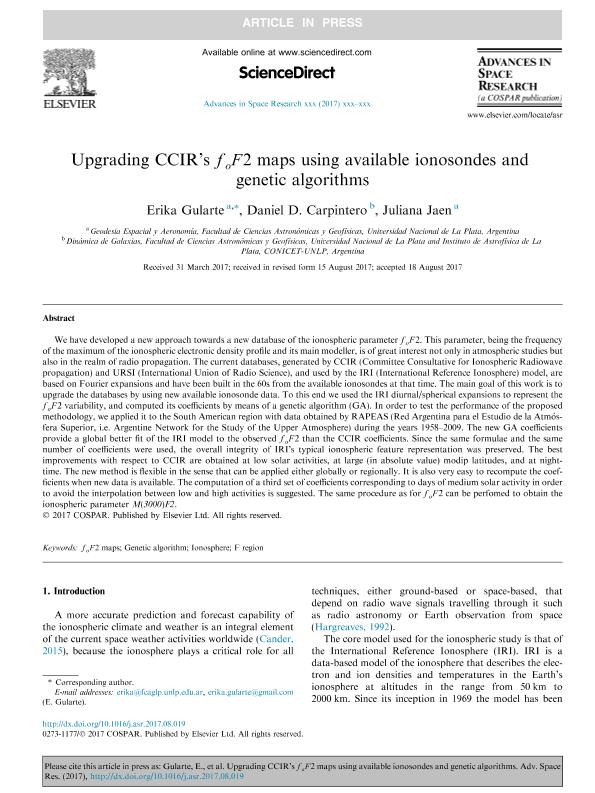Artículo
Upgrading CCIR's foF2 maps using available ionosondes and genetic algorithms
Fecha de publicación:
04/2018
Editorial:
Elsevier
Revista:
Advances in Space Research
ISSN:
0273-1177
Idioma:
Inglés
Tipo de recurso:
Artículo publicado
Clasificación temática:
Resumen
We have developed a new approach towards a new database of the ionospheric parameter foF2. This parameter, being the frequency of the maximum of the ionospheric electronic density profile and its main modeller, is of great interest not only in atmospheric studies but also in the realm of radio propagation. The current databases, generated by CCIR (Committee Consultative for Ionospheric Radiowave propagation) and URSI (International Union of Radio Science), and used by the IRI (International Reference Ionosphere) model, are based on Fourier expansions and have been built in the 60s from the available ionosondes at that time. The main goal of this work is to upgrade the databases by using new available ionosonde data. To this end we used the IRI diurnal/spherical expansions to represent the foF2 variability, and computed its coefficients by means of a genetic algorithm (GA). In order to test the performance of the proposed methodology, we applied it to the South American region with data obtained by RAPEAS (Red Argentina para el Estudio de la Atmósfera Superior, i.e. Argentine Network for the Study of the Upper Atmosphere) during the years 1958–2009. The new GA coefficients provide a global better fit of the IRI model to the observed foF2 than the CCIR coefficients. Since the same formulae and the same number of coefficients were used, the overall integrity of IRI's typical ionospheric feature representation was preserved. The best improvements with respect to CCIR are obtained at low solar activities, at large (in absolute value) modip latitudes, and at night-time. The new method is flexible in the sense that can be applied either globally or regionally. It is also very easy to recompute the coefficients when new data is available. The computation of a third set of coefficients corresponding to days of medium solar activity in order to avoid the interpolation between low and high activities is suggested. The same procedure as for foF2 can be perfomed to obtain the ionospheric parameter M(3000)F2.
Palabras clave:
F Region
,
Fof2 Maps
,
Genetic Algorithm
,
Ionosphere
Archivos asociados
Licencia
Identificadores
Colecciones
Articulos(IALP)
Articulos de INST.DE ASTROFISICA LA PLATA
Articulos de INST.DE ASTROFISICA LA PLATA
Citación
Gularte Scarone, Angela Erika; Carpintero, Daniel Diego; Jaen, Juliana María; Upgrading CCIR's foF2 maps using available ionosondes and genetic algorithms; Elsevier; Advances in Space Research; 61; 7; 4-2018; 1790-1802
Compartir
Altmétricas




